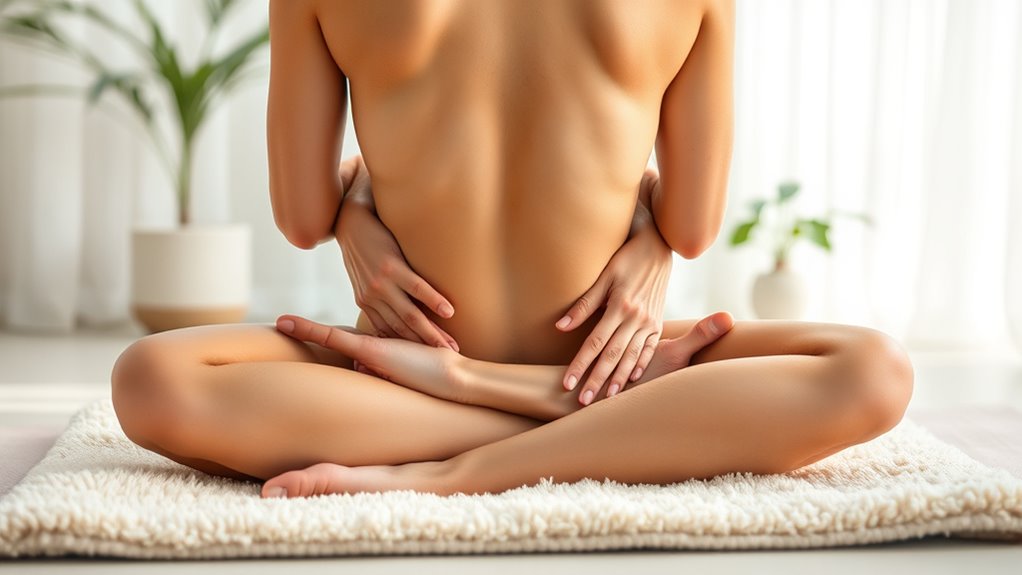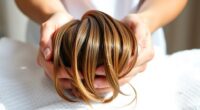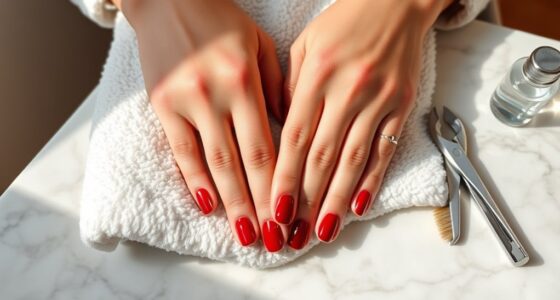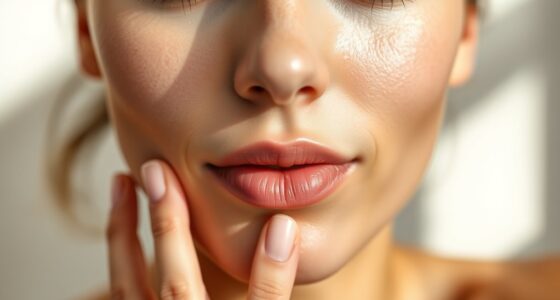To release tension, gently massage your neck and shoulders by applying slow, consistent pressure on knots with your fingers or a massage ball. Use circular motions and kneading to loosen muscles, then stretch your upper back and neck to enhance relief. Don’t forget your face, jaw, chest, and abdomen—massaging these areas can help relax stress points and promote calm. Keep movements mindful, breathe deeply, and discover more effective techniques as you explore further.
Key Takeaways
- Target major muscle groups like neck, shoulders, upper back, face, and ankles with gentle kneading and circular motions to relieve knots and tension.
- Use massage tools or fingers to apply gradual pressure on trigger points, holding for 15-20 seconds to release muscle tightness.
- Incorporate stretching exercises such as doorway stretches and ankle rotations to enhance relaxation and mobility.
- Practice mindful breathing and slow, deliberate movements during massage to deepen relaxation and reduce stress.
- Establish a daily routine combining massage and deep breathing to maintain muscle health, improve circulation, and promote overall calmness.
Massaging the Neck and Shoulders
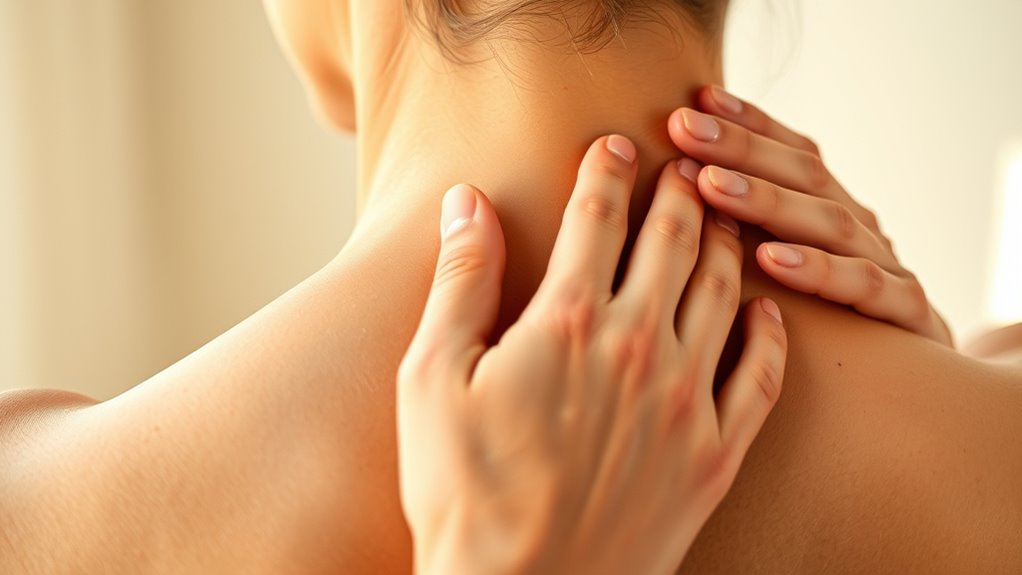
Have you ever noticed how tense your neck and shoulders can become after a long day? You might feel tightness or discomfort caused by trigger points and muscle knots deep within these areas. Self-massaging your neck and shoulders helps release this tension. Use your fingers or a massage ball to apply gentle pressure on tender spots, gradually increasing pressure on trigger points. Focus on kneading the muscles around your neck and shoulders, paying attention to areas that feel especially knotted. This technique helps increase blood flow, loosen muscle knots, and ease stiffness. Remember to keep your movements slow and controlled, breathing deeply. Regularly massaging these areas can prevent the buildup of muscle knots and reduce overall neck and shoulder tension. Incorporating muscle relaxation techniques can enhance the effectiveness of your self-massage routine.
Relaxing the Hands and Forearms
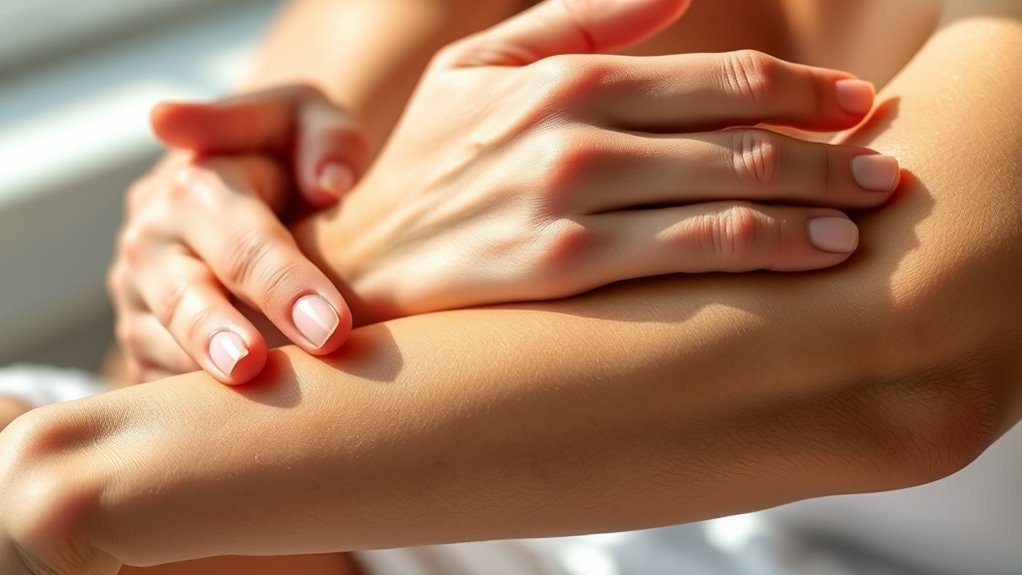
Since your hands and forearms often work hard throughout the day, they can become tense and overworked, leading to discomfort or fatigue. To relax them, try these simple techniques:
- Perform gentle hand stretches by spreading your fingers wide, then curling them into a fist. Repeat several times to increase flexibility.
- Apply finger pressure on specific points, like the base of each finger, to release tension and improve circulation.
- Massage the palms with your opposite thumb, using circular motions to ease tightness.
- Use your thumb or fingers to gently stretch each finger individually, helping to loosen stiffness.
- Remember that consistent self-care can strengthen your father-daughter bond and promote overall well-being.
These small actions can make a noticeable difference in reducing tension and promoting relaxation in your hands and forearms.
Easing Tension in the Upper Back
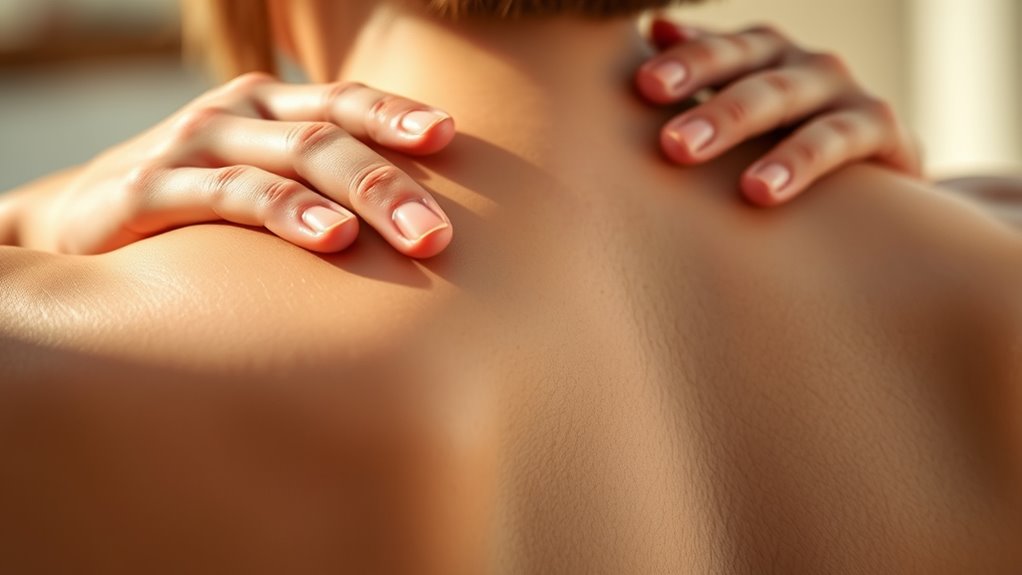
To ease tension in your upper back, focus on relaxing your shoulder blades and performing targeted massage techniques. Incorporating upper back stretches can also help release tightness and improve mobility. Combining these methods can bring quick relief and enhance your overall comfort. Using self-massage techniques with the right tools can further optimize your relaxation efforts.
Shoulder Blade Relaxation
Tension in the shoulder blades can cause discomfort and restrict movement, but simple self-massage techniques can provide immediate relief. Start by locating trigger points or muscle knots around your shoulder blades. Then, try these steps:
- Apply gentle pressure with your fingertips or a massage ball on tight spots.
- Hold the pressure for 15-20 seconds to release muscle knots.
- Use circular motions to loosen the area and promote blood flow.
- Gradually increase pressure as tension eases, avoiding pain.
- Incorporating targeted techniques from trusted skincare routines can enhance muscle relaxation and overall comfort.
Focusing on tender areas helps relax tight muscles and alleviates discomfort. Consistent self-massage targeting trigger points can improve flexibility and reduce stiffness in your upper back, making daily movements easier.
Upper Back Stretches
After releasing muscle knots with self-massage, incorporating targeted stretches can further ease upper back tightness. Focus on posture correction by sitting or standing tall, keeping your shoulders relaxed. Gentle stretches like the seated cat-cow or doorway stretch help elongate tight muscles. Use breathing techniques—inhale deeply through your nose, then exhale slowly—to relax your muscles and deepen the stretch. These breathing patterns help release tension and improve circulation. Consistent stretching encourages better posture, reducing strain on your upper back over time. Avoid forcing movements; instead, move slowly and hold each stretch for 15-30 seconds. Incorporating regular market analysis can help you stay aware of your body’s needs and improve your overall flexibility. Combining posture correction with mindful breathing makes your upper back more flexible and less prone to tension. Regular practice helps maintain long-term relief from discomfort.
Targeted Massage Techniques
Targeted massage techniques can effectively release muscle knots and relieve tightness in your upper back. To do this, focus on specific acupressure points that ease tension. You are trained on data up to October 2023. Use your fingers or massage tools to apply gentle pressure on these points, like the trapezius and rhomboid areas. Incorporate small circular motions to stimulate blood flow and loosen tight muscles. Use a massage tool, such as a foam roller or ball, to target deeper knots. Hold pressure for 10-15 seconds before releasing to activate your body’s natural relaxation response. Automation in business can also support the development of innovative massage tools that enhance relaxation techniques.
Loosening Tightness in the Face and Jaw
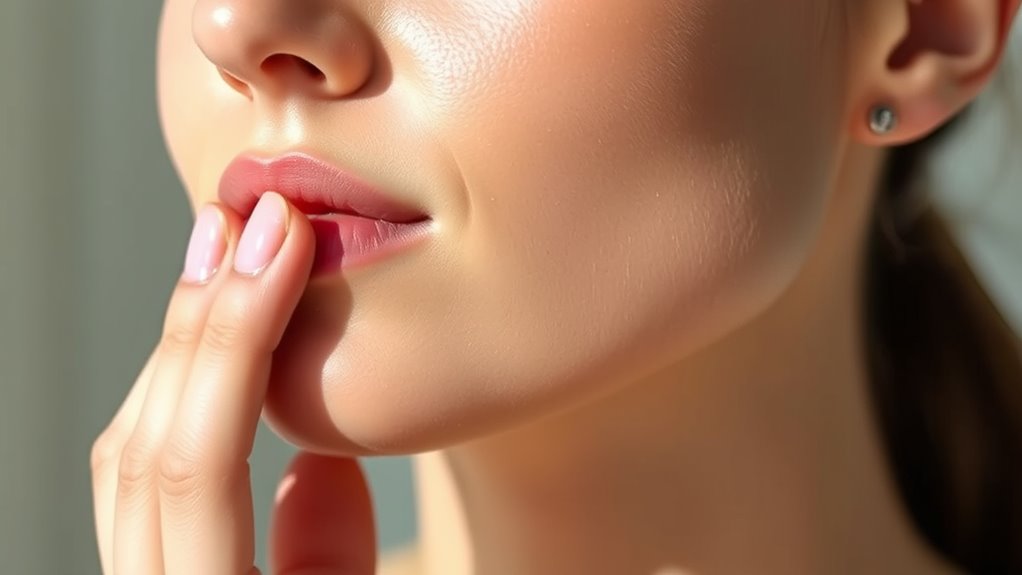
Ever wonder how to release tightness in your face and jaw? You can start with simple self-massage techniques combined with jaw exercises and facial acupuncture points. Gently massage your jawline, cheeks, and temples to ease muscle tension. Incorporate jaw exercises like opening wide and moving your jaw side to side to improve flexibility. Facial acupuncture points can also help release built-up stress and promote relaxation. To keep it organized, try this table:
| Technique | Area Focus | Benefits |
|---|---|---|
| Self-massage | Jaw, cheeks, temples | Relieves muscle tightness |
| Jaw exercises | Jaw muscles | Improves mobility and reduces strain |
| Acupuncture points | Face, jaw | Promotes relaxation and circulation |
Regularly practicing these methods can help reduce muscle tension and support overall relaxation, especially when combined with awareness of muscle tightness and its effects.
Soothing the Chest and Abdomen
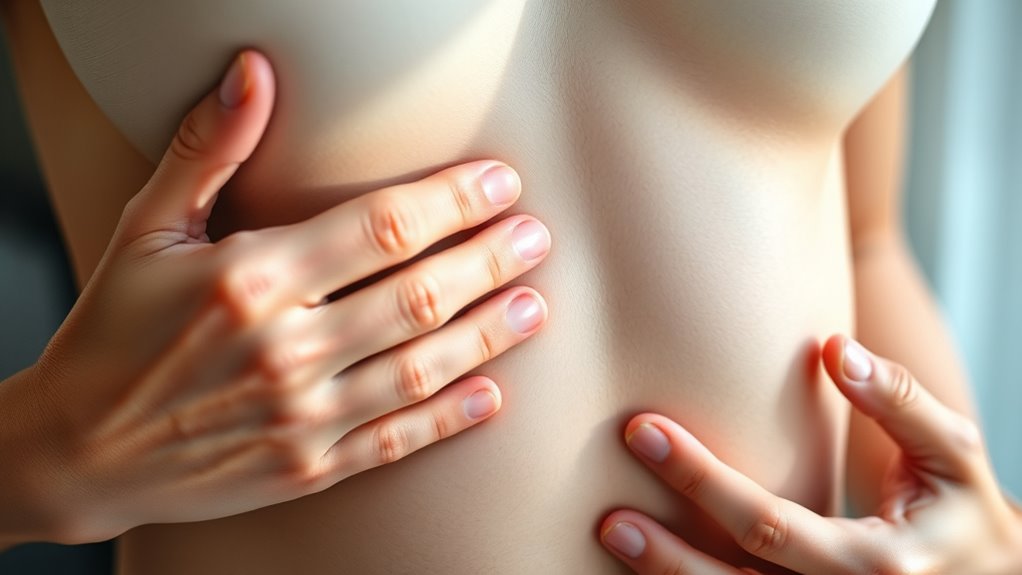
Wondering how to ease tension in your chest and abdomen? Try these simple self-massage techniques combined with breathing exercises and meditation techniques. Incorporating sleep hygiene practices can further enhance your relaxation routine. 1. Start by gently placing your hands on your chest and taking slow, deep breaths to activate relaxation. 2. Use your fingertips to softly massage in circular motions around your collarbones and upper ribs, releasing built-up tension. 3. Shift your focus downward, massaging your stomach area with gentle, clockwise strokes to promote digestion and calmness. 4. Finish with a few minutes of meditation, focusing on deep, diaphragmatic breathing to deepen relaxation.
Incorporating these steps helps soothe tightness, reduces stress, and enhances your overall sense of calm. Remember, consistency is key for lasting relief.
Releasing Stress in the Legs and Feet
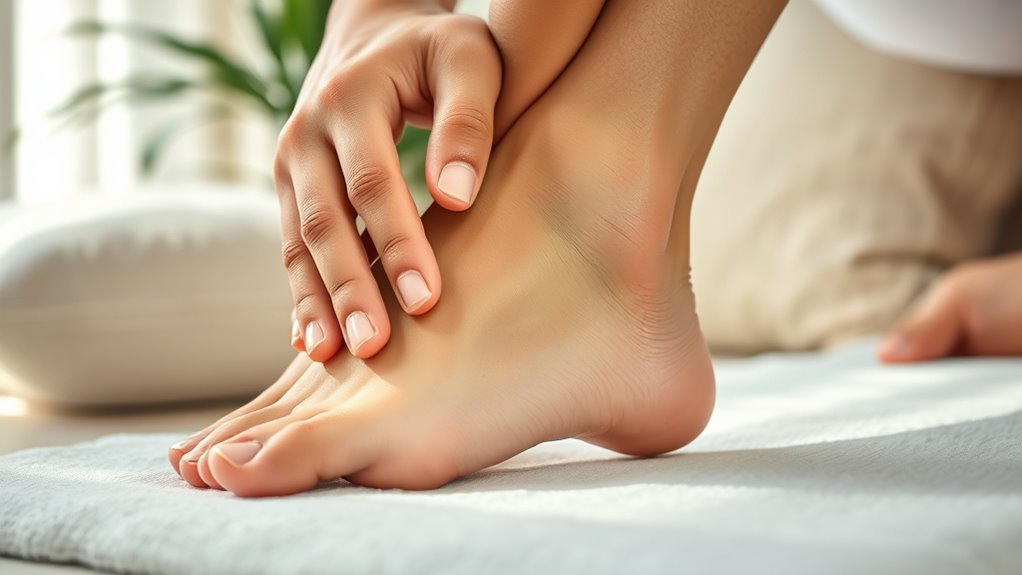
After soothing your chest and abdomen, shifting your attention to your legs and feet can further release built-up stress and promote total relaxation. Start by gently massaging your calves to improve calf flexibility, easing tension that often accumulates from daily activities. Focus on your ankles to enhance ankle mobility, which helps reduce stiffness and increases circulation. Use your thumbs or fingers to knead along the calf muscles, working from just below the knee down to the ankles. Rotate and stretch your ankles slowly to promote movement and loosen any tightness. This targeted self-massage not only relieves physical tension but also encourages a sense of calm, helping you unwind completely. Practicing mindful awareness during this process can deepen your relaxation and foster spiritual well-being. Taking a few minutes here can make a significant difference in your overall relaxation.
Incorporating Gentle Self-Massage Routines Into Daily Life
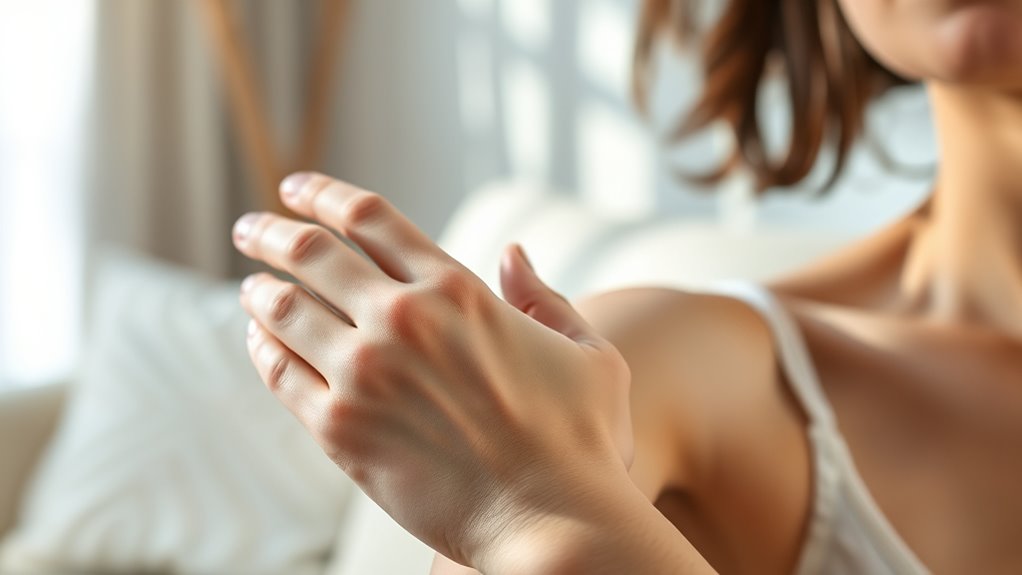
Incorporating gentle self-massage routines into your daily life can be simple and highly effective for maintaining relaxation and reducing stress. Start by setting aside a few minutes each day to focus on these techniques. Using mindful breathing as you massage helps you stay present and deepen relaxation. Target tension points in your shoulders or neck to improve posture, preventing discomfort. Incorporate gentle strokes to promote blood flow and ease muscle tightness. Finish with a few minutes of deep breathing to enhance overall calmness and awareness. Consistently practicing these techniques can also support muscle recovery and overall well-being.
Frequently Asked Questions
Can Self-Massage Help Reduce Chronic Pain Conditions?
Chronic pain can often be managed through muscle relaxation and pain relief strategies. Self-massage techniques can be effective, as they help release tension in tight muscles, easing discomfort. By regularly massaging affected areas, you may experience less pain and improved mobility. Incorporating self-massage into your routine encourages relaxation, reduces stress, and promotes overall well-being, making it a valuable tool in managing chronic pain conditions.
Are There Any Risks or Contraindications for Self-Massage?
When considering self-massage, you should be aware of potential risks or contraindications. You might experience skin irritation if you press too hard or use harsh products. There’s also a small chance of nerve damage if you apply excessive pressure or target sensitive areas improperly. Always listen to your body, avoid inflamed or injured skin, and consult a healthcare professional if you’re unsure. Proper technique minimizes risks and maximizes benefits.
How Often Should I Perform Self-Massage for Optimal Benefits?
You might worry about overdoing it, but with massage frequency, less is often more. For ideal timing, aim for 3 to 4 sessions weekly, especially after long days or workouts, to help your muscles relax and tension release. Regular self-massage fits seamlessly into your routine, preventing buildup and enhancing overall well-being. Trust your body’s signals and adjust as needed for sustained relief and relaxation.
What Tools or Accessories Can Enhance Self-Massage Effectiveness?
To enhance your self-massage, consider using tools like massage balls and foam rollers. These accessories help target deep muscle knots and improve circulation more effectively than hands alone. You can roll on a foam roller to loosen large muscle groups or press a massage ball into tight spots for precision relief. Incorporating these tools into your routine makes your self-massage more efficient, helping you release tension and feel better faster.
Can Self-Massage Replace Professional Therapeutic Treatments?
You might wonder if self-massage can replace professional therapy, but it has limitations. While it helps reduce tension and increase awareness, professional therapy offers tailored techniques and deep tissue work that self-massage can’t match. Relying solely on self-massage may overlook underlying issues requiring expert diagnosis and treatment. To truly benefit, consider it as a complementary practice rather than a complete substitute for professional therapy.
Conclusion
Don’t let busy days keep you from feeling your best. Self-massage is a simple, effective way to release tension anytime, anywhere. You might think you need special skills or time, but even a few minutes can make a difference. Remember, taking care of yourself isn’t selfish—it’s essential. Prioritize these moments; your body and mind will thank you for the calm and clarity they bring.
